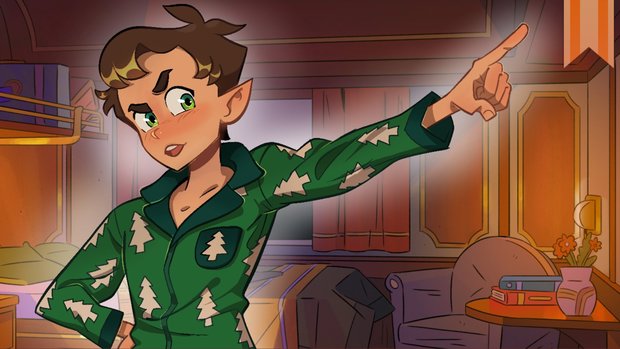Arcane Investigations review

- 0 Comments
Short but charming Ace Attorney clone is worth looking into for fans of legal visual novel-styled mysteries
I’ve been a fan of the Ace Attorney series for over a decade at this point; it’s been a part of my life since high school, at the very least. So when indie studio What’s All That Racket released a game that they advertised as a “Phoenix Wright-inspired mystery comedy,” I was interested – and after playing the game I can say that the description is accurate. The game has some hiccups, which is only to be expected from a small team’s debut, and it’s very short, ending just when it should be picking up, but at its best it gave me the same chills I feel when I’m playing a Phoenix Wright case for the first time – and that’s a pretty impressive feat.
As this is a mystery game, details about the story will have to be kept to a minimum. In Arcane Investigations, players take control of Kabili, a freshly accredited Arcane Investigator for the Magisterium Bureau of Investigation, as he travels via train to the Capital so that he can start his new job. Unfortunately, a powerful gem is stolen on the way and as magic use is suspected in the crime, Ismeta (a humanoid fish woman witch who is also traveling on board) is accused of the theft. It’s up to you to defend Ismeta in a trial on the train that very night and find the real culprit before you reach your destination – the thief (and gem itself) are still on the train, somewhere.
It’s a setup that could fit easily into the opening of an Ace Attorney game, though veterans of that franchise might note a lack of death in this synopsis. Most of the cases in Capcom’s games center around a murder, whereas here the crime is simply theft. Though this works towards creating a cozier experience, the lower stakes make some of the story beats feel less impactful. Murder is better as a motivation to want to catch the bad guy – to sweat them out in court, really make them answer for their crimes. It’s a feeling I get when I play other mystery games, and one that this game failed to produce in me. That being said, I still had a client to defend here and I walked away feeling positive about the game. It took about an hour to complete, and when I was done all I wanted was more.
One of the reasons the game worked for me was the handful of diverse characters. They’re all hand-drawn and it was a highlight for me to see all the wonderful designs, overlaid in the foreground against the various environments like a standard visual novel. There’s Willa, our empathic partner, who appears to be part plant, with leaves in her hair and bark grooves on her arms. Zircon, a chrome-colored floating eye automaton (who can also wear a funny little hat, if you choose). My favorite is Oberon, the secretary bird-inspired prosecutor, with his wings tucked behind him and all his jewelry and sharp eyeshadow. Kabili himself has two different looks; he starts the game in his pajamas and you’re given three separate chances to change out of them. Or you could play the entire game wearing them (which I did, of course).
They’re all written very well too. Unlike in some Ace Attorney cases, never was there a character I dreaded needing to talk to. They all have very defined and varied personalities: Kabili’s nervous excitement bounces off the bursting-with-joy Willa and the robotic Zircon. It’s a treat talking to them all and learning about their lives and the world they live in. While there are dialogue options, none of your decisions will impact the story. There are, however, two points where the game gives you the choice of picking who you’d like to talk to, with only enough time to explore one of the options. This creates a bit of replay value, as you can go back and talk to other characters next time (or you could load a save – there’s manual saves as well as automatic).
Most of the screens are static first-person shots of the train cars as you investigate them. Like the characters, they’re all drawn by hand in a cartoon-like style and there’s a good balance between simplicity and detail that makes everything very readable and just plain nice to look at. The lighting does a lot to help with the tone; every room is lit with these warm, yellow-orange lights that make you feel relaxed. In places like Ismeta’s room, the warmth of the lighting is contrasted with cooler colors like blues and purples, creating the exact kind of environment I’d expect from a cozy fantasy mystery.
Sticking with the Phoenix Wright comparisons, fans of those games will feel right at home with the interface of Arcane Investigations. The game plays like most other visual novels: there’s a black box near the bottom of the screen for dialogue, choices appear in the middle of the screen when they come up, topics of conversation on the left, and there’s a button for your inventory on the bottom right, as well as a bookmark at the top that takes you to the options and save screens. The whole game can be played with only a mouse, if that’s what you want. Ren'Py, the engine the game runs on, also provides a text-to-speech hotkey (‘V’) if that’s needed. The game also hypothetically supports controllers, which I tried for a little bit, but while it worked fine in the visual novel portions, it really struggled to select things during the investigation side of the game.
Investigation consists of moving the mouse around the screen and clicking on objects of interest. No pixel hunting here; when you hover over a hotspot, the whole object will glow white. This, with the addition of a tally in the bottom left, is a nice quality-of-life feature that lets you know how many more items there are before you’ve seen everything a room has for you. There are no puzzles during this section; all you’re doing is collecting clues and information. However, sometimes when you click on one of these objects, you’ll get a piece of evidence that goes right into your inventory. You can open the inventory up at any time and read descriptions of the items in there. It’s important to read these, as they’ll be important during the trial portion.
The trial itself plays similarly to the ones in Ace Attorney, if a bit watered down. Zircon acts as judge, with Oberon the prosecution and Willa your co-defense. Suspects will take the stand and give testimony; like all dialogue, it appears in the black box near the bottom of the screen. The only change is the addition of arrows, allowing you to go back and forth through the suspect’s statement as much as you want. There’s no cross examination button here – the game tells you that there’s always a contradiction somewhere in the testimony. All you have to do is present the right evidence at the right section to proceed.
There’s a hint system if you’re stuck, and if even that doesn’t help, you can choose to bypass the puzzle altogether. Not that one would really need to – trial and error works just as well if you can’t figure out the answer. There’s no penalty for presenting the wrong evidence for the wrong statement, meaning you can just keep trying every inventory item and every statement until one clicks. I find this to be one of the downsides of the game. It’s a system designed for a casual, cozy experience, so it’s harder for me to get invested in a game when there are no stakes for the player, no chances of losing or experiencing any kind of consequence for failure.
That probably doesn’t end up mattering much, though, as I never needed to use the hint system, and only near the end did I struggle with finding the right evidence for the statements. I was always on the right track; I just had a little trouble finding the right portion of testimony to present the evidence. Any fan of these types of games will probably have a similar experience. Even for someone less familiar with them, all you really need to do is open up the inventory, read all the item descriptions, and then read the statements again. You’ll find a contradiction in no time.
Music can help make or break the courtroom scenes in games like these. Some of the most memorable tracks in the Ace Attorney games come from the trials. Unfortunately, I found the score lacking in Arcane Investigations. It appears to be a collection of tracks from the public domain, and you can feel that while playing. It’s all synthesized and, as a whole, I’d describe them as chill – the kind of music you might listen to while studying. While it does fit the relaxed tone the game is going for, a unique score would have done a lot to elevate the experience and make it more immersive. For instance, there was one track I heard a few times while a suspect was testifying; a repetitive “dun-dun-dun-dun” that sounded like it was building to a greater musical moment. It never did; disappointingly the track just stopped when I went through the dialogue.
The sound effects are pretty standard too. If you’ve played any games like this, you’ve heard variations of them all before. The issue with them here is a technical one. I started playing with my volume settings turned all the way up and found that the music overpowered all other sounds: the little chirps characters make when they talk, the “twack” noise when someone gets hit with a realization; even the sharp objection sting was drowned out by the music on the default settings. Though you can adjust the volume of the music and sound effects separately, I had difficulty finding a good balance between them. More often than not, I’d wind up with one or the other being too low.
It’s not all bad on the audio front, though, as there was a particular moment when everything came together. I had presented evidence on a statement early in the trial and the music stopped, replaced with a single, building note as Kabili worked through his argument. Then it happened. A sharp sound effect cut through the scene, Kabili was pointing as he exposed the contradiction, and the music shifted into a faster-paced electronic beat. It’s a feeling you only get with these kinds of games; the “Aha!” moment when you catch the suspect in a lie. It’s the whole reason I play games like this, and I’m glad that Arcane Investigations was able to deliver it, if only temporarily.
The case ends in a satisfying, if predictable, way. There’s only so many characters, after all, and I wouldn’t say there’s much of a twist in finding out who the thief was. The problem is how open the game itself leaves things. It’s something that I would expect out of the first case in an Ace Attorney game, where you get more cases in the game to pick up where the last left off. Here, though, it feels off. It’s not certain that Arcane Investigations will ever get more cases and, if it doesn’t, the open-endedness of the finale doesn’t work well for a standalone game.
Final Verdict
If it sounds like I’m being harsh, it’s only because I find the characters and concept of Arcane Investigations so interesting. I want to see where the story picks up from here. This is a good game, especially for the studio’s first – but with a few notes. While some may be fine with the hour-long length (and I get it; I enjoy a short and sweet game sometimes too), I feel like this game was just only starting to break the surface of what a fantasy Ace Attorney could be. It’s fun while it lasts, and with the accessibility options, hint system, and option to skip puzzles, no one should struggle to reach the end. What’s All That Racket seems like a wonderful new team, and if they add a composer and more substance to their next game, I’m eager to see more adventures with Kabili and his friends.
Hot take
The magical world it sets up begs to be explored more deeply than it is here, but while it lasts, the hour-long Arcane Investigations largely succeeds in its promise of being a Phoenix Wright-inspired fantasy mystery.
Pros
- Delightfully cozy hand-drawn graphics
- Characters are full of life and personality
- Some of the same whimsy and fun as its Ace Attorney inspiration
Cons
- Soundtrack leaves a lot to be desired
- Very short
Micah played Arcane Investigations on PC using a review code provided by the game's publisher.











0 Comments
Want to join the discussion? Leave a comment as guest, sign in or register.
Leave a comment